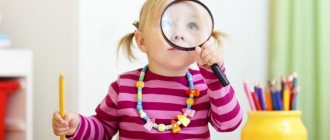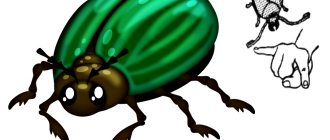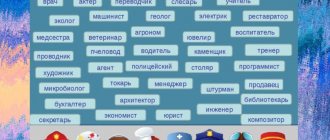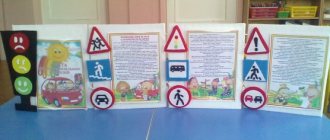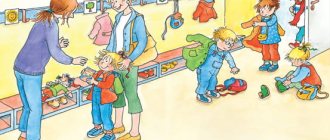The importance of didactic games and toys in the education of young children
Educational games and educational toys are of great importance in the learning, learning and development of young children. After all, it is a game and a toy that can simultaneously teach, educate and bring joy to a child.
From an early age, a child actively learns about the world around him, through studying what is happening around him. In this knowledge, he is actively helped by educational games and toys, which help expand the child’s horizons, teach him to observe and highlight the characteristic features of objects, and establish simple relationships between them.
Too lazy to read?
specialists and get an answer in 15 minutes!
Ask a question
Educational games and toys are of particular importance in the education of young children, since with their help children learn and assimilate the norms and rules of behavior in society and acquire skills of interaction with others. All these skills are necessary for children not only for successful subsequent studies at school, but also for successful socialization in society.
Observation 1
A didactic game and a toy are inseparable from each other. Thus, an educational toy can become the beginning of a game during which a storyline unfolds that requires additional toys.
The value of educational games and toys is that they introduce children to life, promote their mental development and provide opportunities for all types of children's activities.
Is the potential of the toys available in kindergarten sufficiently realized?
You can justify pedagogical failures by insufficiently modern play equipment for groups, or you can, having only “basic” toys at your disposal, make their “utility coefficient” maximum. For example, it is one thing to offer boys day after day to tinker with a finished railway, directing a train with carriages along it; then put it on the top shelf. And another thing is to once ask them to come up with a plot for a game in which passengers, conductors, purposes of the trip, etc. will appear; the second time - experiment with the trajectory of movement, and the third time - focus on changing the number of trailers.
Lapbook “Toys”. Didactic games for primary preschool age
Yulia Sochilova
“Toys” Lapbook. Educational games for preschoolers
Lapbook. Toys. (for younger children)
This laptop can be used to introduce toys on the topic “Toys”, you can repeat the topic “Toys”. Lapbook is inert in working with children in groups and individually, as well as in relation to lessons in the evening, outside of lessons, parents can consolidate their knowledge on the topic of toys together with their children. This laptop includes a variety of educational games: 1 One-Many Educational Game. Goal: to develop the ability to distinguish between the number of objects, many and one.
.2, didactic game Dress the doll Purpose: to teach children to choose and name suitable clothes (for girls. For boys to develop aesthetic taste.
.3 didactic game The fourth extra object Purpose: to strengthen in young children the ability to find the fourth extra object and explain why the object is extra.
.4 didactic game Circle and color Purpose: To develop fine motor skills, a sense of color, perseverance, and accuracy in young children.
.
.5 educational game Find my shadow Purpose: to teach young children to find given silhouettes of objects, animals, toys; develop children's visual perception, attention, and observation skills.
.
.6 didactic game Dress up the matryoshka Purpose: to teach young children to memorize geometric shapes (circle, square, rectangle, triangle, teach to group objects by color, correlate geometric shapes by shape by overlapping.
.7 educational game Cropped pictures Purpose: to teach young children to form a whole consisting of two parts, to develop logical thinking, visual perception, and attention.
What else to read: Space: lessons on the world around us (middle group)
.8 educational game Consider and color Goal: to develop visual perception in young children, the ability to guess and name a toy, choose the color of a pencil for coloring a toy, the ability to hold a pencil correctly, develop fine motor skills, develop accuracy and consistency,
.
.
.9 didactic game with lacing My toys Purpose: to teach young children to correctly name a toy according to its external characteristics according to poems read by adults in order to make up a story about this toy (why do you need such a toy, like plays with it, the one who plays with it, develops and replenishes vocabulary, finds the necessary parts of the toy and connects with a rope, develops fine motor skills.
educational game .ten Collect a picture Purpose: To introduce young children to a variety of toys, do exercises on creating pictures from geometric shapes (you can use a constructor)
develop sensory perception of fine motor skills of the hands.
Integrated lesson in the senior group on the topic “Toys”
Summary of an integrated lesson
in the senior group on the topic “Toys”
Purpose :
Clarification, expansion and activation of
children's
.
Tasks:
Correctional – educational:
children's vocabulary
in the words of the thematic
group “ Toys ”
;
- improve the grammatical structure of speech
: to develop the skill of forming and using diminutive forms of nouns, using nouns in R. p., units. h.;
— continue learning to answer questions in complete sentences.
Corrective and developmental
:
- create conditions for the use of new words in your own speech;
- develop speech breathing;
- develop fine and gross motor skills, a sense of rhythm, coordination of speech with movements;
- develop intelligence, attention, memory, speech hearing.
- develop the ability to work at a certain pace;
Correctional and educational:
- cultivate interest and attention to the word, one’s own speech and the speech of others.
- to form goodwill, independence, activity.
Equipment:
toys
(horse, boat, ball, bear, bunny, locomotive, car, etc.)
. Pictures of toys.
Progress of the lesson:
The teacher invites the children to go to the table on which there is a letter.
Educator: Guys, look, someone sent us a letter. The letter is from Masha. She writes that all her toys were hidden by the wolves. And she is very sad without them. And in this letter there are tasks from the wolves that we must complete in order to return the toys to Masha. Guys, let's help Masha find her toys?
Children: ( children's answer
).
Guys, in order to successfully complete the tasks, you and I need to stretch our fingers.
Finger gymnastics “Toys”
(Work on the tempo and rhythm of speech.)
On a large sofa in a row ( They alternately clap their hands and bang their fists.)
The Car dolls are sitting: Two bears, Pinocchio, (
Bend all their fingers in turn.)
And cheerful Cipollino, And a kitten, and a baby elephant.
One, two, three, four, five, (Bend their fingers alternately.)
We help our Masha
(Alternately clap our hands and knock with our fists.)
We count the toys.
Educator: Guys, in order to find us Toy Cars we need to complete the tasks sent by the wolves. Let's open the first task.
Game “Name it kindly”:
Doll - doll;
Hare - bunny; and so on.
Well done, you completed this task.
Next task:
Game "What has changed?"
The toys are in a certain sequence and the teacher invites the children to look carefully and remember how they stand. Children close their eyes, the teacher changes places of the toys.
The game "What's missing?"
The teacher removes one toy and asks the children to name the object that was removed. Well done, you are doing well.

